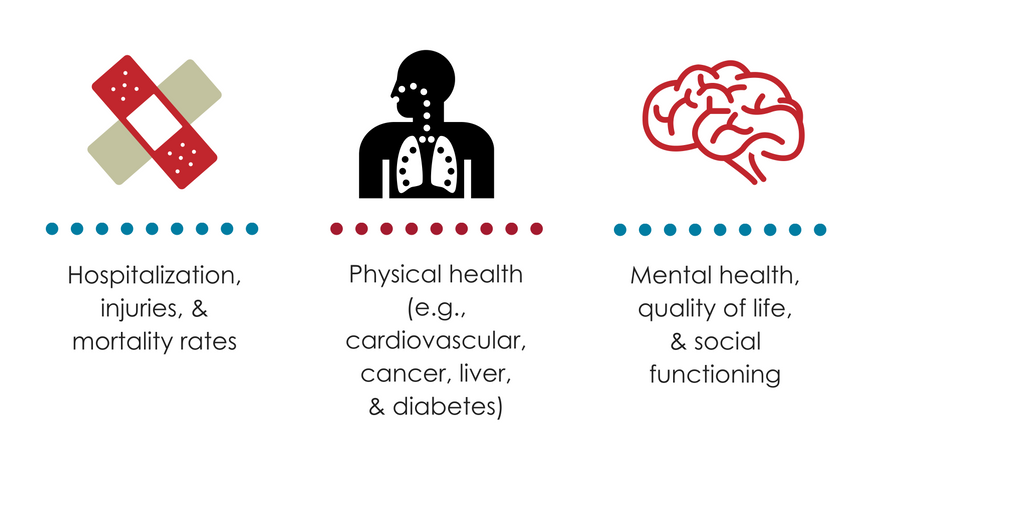Reducing or Quitting Drinking? An Extensive Review of Health Benefits
Harmful drinking and alcohol use disorder are among our nation’s most challenging public health problems.
What happens to people’s lives when they reduce drinking and does it have as great an impact as if they quit entirely?
WHAT PROBLEM DOES THIS STUDY ADDRESS?
Alcohol use disorders and other types of harmful drinking account for 12% of all years lived with a disability or lessened due to early death for males and 5% for females. Alcohol-related costs due to lost work productivity, health care, and criminal justice, total $250 billion each year just in the United States.
Much can be learned from research that investigates how reducing or quitting alcohol provides benefits in terms of individuals’ day-to-day lives. In this study, Charlet and colleagues conducted a large review of 59 studies that addressed these important issues, providing key information on whether and to what extent changing drinking is beneficial.
HOW WAS THIS STUDY CONDUCTED?
The authors performed an extensive, systematic review of thousands of potential studies targeting effects of reducing drinking on physical and mental functioning. A systematic review means authors start with specific search terms in databases that contain hundreds of thousands of scientific articles, and criteria that needed to be met for the studies to be included in the review. This way, the review could be repeated by another research team if desired. In this case, the studies needed to measure the effects of alcohol reduction on physical or mental functioning, and they needed to measure the exact amount of alcohol (e.g., in grams of pure ethanol), rather than simply number of drinks.
In the United States, for example, there are 14 grams of ethanol in a standard drink (1 beer, 1 glass of wine, or one shot of liquor) whereas in other countries like Australia a standard drink contains 10 grams of pure ethanol. Also if the study included individuals that received an intervention (i.e., intended to help people reduce or quit drinking), the intervention had to be psychosocial, meaning patients did not receive medication. Studies did not need to test an intervention, however. They could also follow a group of drinkers over time, called a prospective cohort study, or even simply assess them at one single point, called a cross-sectional study.
WHAT DID THIS STUDY FIND?

Hospitalization, Injuries & Mortality (i.e., death) Rates:
Studies generally show that reducing drinking is related to reductions in injuries and likelihood of death over the long-term, but not over the short-term (e.g., less than 1 year). For example, in one study, reducing one’s weekly drinking by about 30% (in total volume) was related to fewer injuries and 44% fewer sick days over a 2-year period. Despite benefits of reducing drinking, abstinence seems to be the safest and most impactful strategy. For example in one study of alcohol use disorder treatment patients, across 16 years of follow-up, 73% of individuals who relapsed died while only 30% of abstainers died – primarily from heart attack or heart failure (more on this in “Why is this study important” below).
In addition, while studies tend not to find helpful effects of drinking reduction on health care utilization, abstinence, on the other hand, tends to be related to less health care utilization. Importantly, though, treatments that help people reduce their drinking – rather than quit entirely – are indeed related to less health care utilization and longer time to hospital readmission on the whole. It appears to be something gained from the treatment itself, though, rather than the drinking reduction that is helpful. This is known because drinking reductions were similar in the treatment and comparison groups. In the same 16-year follow-up, for those abstinent in the year before the follow-up assessment, only 18% were hospitalized compared with 43% who were non-abstinent.
Overall, drinking reduction interventions can save hospital systems about $1000 per patient per year.
Physical Health:
One of the most commonly studied issues in alcohol research is the effect of drinking on cardiovascular functioning. Generally, except in the most mild drinkers (less than 1 drink per day on average), drinking reductions are related to better cardio outcomes. In one study with moderate drinkers who were drinking 3-6 drinks daily, reducing drinking by 67% was related to improved (i.e., reduced) blood pressure, an average of a reduction by 3 systolic points over 2 diastolic points.
For cancer, while there is strong evidence that drinking is linked to esophageal cancer overall and breast cancer among women – alcohol is considered a Level 1 carcinogen (i.e., known to cause cancer) by the International Agency on Cancer Research – there is very little data on how actively reducing alcohol specifically affects likelihood of developing cancer. Not surprisingly, reducing drinking can substantially improve liver functioning – authors suggest total abstinence is the most effective approach for individuals with alcohol related liver problems.
For individuals with Type II diabetes, reduced drinking provides no benefit in insulin; there even seems to be some data suggesting moderate drinking (up to 2 drinks per day) could help improve insulin sensitivity. How the risks of drinking balance out this potential benefit, if it is found to be causal, for those with Type II diabetes is not yet clear.
Mental Health, Quality of Life & Social Functioning:
For individuals with alcohol use disorder , reduced drinking generally helps reduce depression, anxiety, and enhance self-esteem.
Based on 8 studies, the research suggests that abstinence may be needed for individuals with harmful drinking – defined in this review as drinking at least 3-4 drinks on average per day in men and 2-3 in women depending on the study – or alcohol use disorder, to achieve social benefits. For example, in three separate randomized trials, reduced drinking did not lead to changes in anxiety or life satisfaction.
WHY IS THIS STUDY IMPORTANT
For individuals with alcohol use disorder who make an effort to get treatment but do not end up receiving it, 25% say the reason was that they were not ready to stop drinking or using drugs. Also, for people in remission from severe alcohol use disorder, meaning they no longer have symptoms of the disorder, 65% are still drinking but not at problematic levels. In combination with the proliferation of treatments designed to help individuals reduce rather than quit drinking, these statistics are indicative of the need to understand the benefits of reduced drinking.
This review shows while there are many health benefits of reduced drinking, that tend to take several years to accumulate, the safest strategy is likely to be quitting altogether if one is willing to go that route.
This is consistent with another important study showing there is a greater likelihood that alcohol use disorder symptoms will resurface and that there will be a complete return of alcohol use disorder for individuals in remission who are drinking versus those who are completely abstinent. Even the body of studies finding that very mild drinking could have cardio-protective effects appear to be somewhat in doubt. In a previous Bulletin, we reviewed a study that took a look closer at this issue, which concluded that abstinence is still likely to be the safest strategy when it comes to mortality risk over time.
- LIMITATIONS
-
- This review did not produce numerical estimates of reduced drinking as might be done in a meta analysis – a study that analyzes many studies at once. The overall findings were based primarily on the authors’ interpretations of the 59 studies reviewed.
NEXT STEPS
Comparisons of abstinence versus reduced or controlled drinking (sometimes called “harm reduction”) remains a hot topic in addiction treatment and recovery research. It would be helpful in future research to parse out the benefits and drawbacks of each potential pathway to drinking problem resolution and which individuals may be most likely to benefit the most from any given pathway.
For example, while interventions that emphasize or allow for drinking reduction rather than abstinence may attract more individuals with alcohol problems – and thus have potentially greater reach – they may possibly have a smaller positive impact on health and wellness.
BOTTOM LINE
- For individuals & families seeking recovery: Reducing drinking is likely to have multiple physical health benefits over the long-term. Abstinence, however, is likely to produce larger benefits on the whole across a range of areas including your physical and mental well-being.
- For Scientists: This extensive review suggests alcohol reduction and abstinence will both have positive health gains, with the latter having greater and broader gains. Given that many individuals prefer to try to resolve their problem without quitting entirely – at least initially – rigorous research comparing reduced drinking and abstinence on health outcomes would provide critical information for the health care field.
- For Policy makers: The impact of an intervention is a function of both effectiveness and reach. While abstinence is likely to provide greater gains across multiple domains relative to drinking reductions, many individuals prefer to try to reduce drinking as a way of resolving their problem. Therefore, strategies focused on reduction may have broader reach (via broader appeal). The greater impact of abstinence-based strategies versus the greater reach of reduction-based strategies will likely both play in a role in policy related decisions.
- For Treatment professionals and treatment systems: The impact of an intervention is a function of both effectiveness and reach While abstinence is likely to provide greater gains across multiple domains relative to drinking reductions, many individuals prefer to try to reduce drinking as a way of resolving their problem. Therefore, strategies focused on reduction may have broader reach (via broader appeal). It may be helpful, therefore, and potentially cost-effective as well from a treatment system perspective, to offer both types of approaches and to work with patients to achieve optimal behavioral and physical health that is informed by findings such as those in this study.
CITATIONS
Charlet, K., & Heinz, A. (2016). Harm reduction—a systematic review on effects of alcohol reduction on physical and mental symptoms. Addiction biology.

